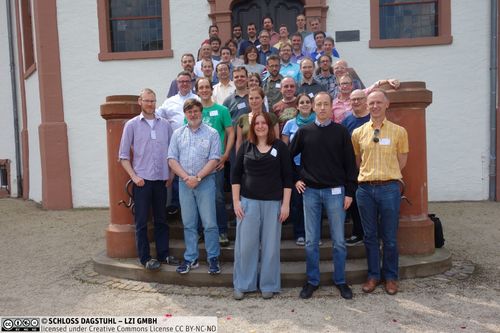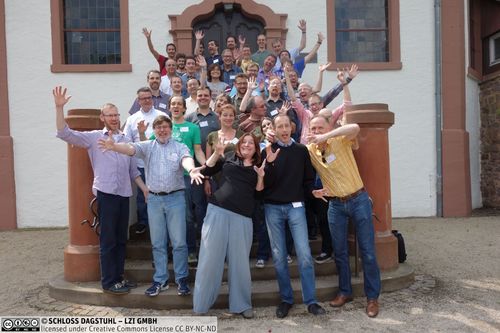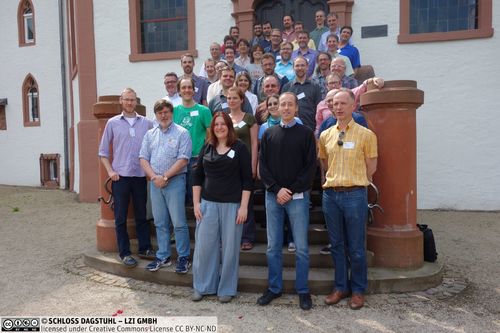Dagstuhl Seminar 16231
Immersive Analytics
( Jun 05 – Jun 10, 2016 )
Permalink
Organizers
- Tim Dwyer (Monash University - Caulfield, AU)
- Nathalie Henry Riche (Microsoft Research - Redmond, US)
- Wolfgang Stuerzlinger (Simon Fraser University - Vancouver, CA)
- Bruce Thomas (University of South Australia - Mawson Lakes, AU)
Coordinator
- Karsten Klein (Universität Konstanz, DE)
Contact
- Annette Beyer (for administrative matters)
Impacts
- An Evaluation of Interaction Methods for Controlling RSVP Displays in Visual Search Tasks : article in Big Data Visual Analytics (BDVA), 2016 - Waese, Jamie; Stuerzlinger, Wolfgang; Provart, Nicholas J. - Los Alamitos : IEEE, 2016. - 8 pp..
- Demonstrating David Meets Goliath Combining Smartwatches with a Large Vertical Display for Visual Data Exploration : article in CHI EA '18 Extended Abstracts of the 2018 CHI Conference on Human Factors in Computing Systems - Horak, Tom; Badam, Sriram Karthik; Elmqvist, Niklas; Dachselt, Raimund - New York : ACM, 2018. - 4 pp..
- ePlant : Visualizing and Exploring Multiple Levels of Data for Hypothesis Generation in Plant Biology : article - Waese, Jamie; Fan, Jim; Pasha., Asher; Sternberg, Michael J.; Krishnakumar, Vivek; Ferlanti, Erik; Miller, Jason; Town, Chris; Provart, Nicholas J.; Stürzlinger, Wolfgang; Kelley, Lawrence A.; Cumming, Matthew; Shi, Ruian; Fucile, Geoffrey; Yu, Hans - Rockville : American Society of Plant Biologists, 2017. - pp. 1806-1821 - (The Plant Cell ; 29. 2017, 8 : article).
- HoloStation : Augmented Visualization and Presentation : article in SA '16 : SIGGRAPH ASIA 2016 Symposium on Visualization - Kim, Minju; Lee, Jungjin; Stürzlinger, Wolfgang; Wohn, Kwang Yun - New York : ACM, 2016. - 9 pp..
- Immersive Analytics - Marriott, Kim; Schreiber, Prof. Falk; Dwyer, Tim; Klein, Karsten; Riche, Nathalie Henry; Thomas, Bruce H.; Stürzlinger, Wolfgang; Itoh, Takayuki - Berlin : Springer, 2018. - XI, 357 S. - (Lecture notes in computer science : State-of-the-Art Survey ; 11190).
- Immersive solutions for future Air Traffic Control and Management : article in ISS Companion '16 : Proceedings of the 2016 ACM Companion on Interactive Surfaces and Spaces - Cordeil, Maxime; Dwyer, Tim; Hurter, Christophe - New York : ACM, 2016. - pp. 25-31.
- Proceedings of the 10th Joint Workshop of the German Research Training Groups in Computer Science : Dagstuhl 2016, May 22nd - May 25th - Etzold, Benedikt; Richter, Rene; Eibl, Maximilian; Lehner, Wolfgang - Chemnitz : Universtitätsverlag, 2016. - XIV, 225 Seiten. ISBN: 978-3-944640-88-4 / 3-944640-88-8.
We are living in the era of big data and the amount and complexity of data in many domains is growing at an increasing rate. The analysis of such complex data sets is not only the subject of research in natural and social sciences, biomedicine and economics, but is also an integral part of effective planning in business, government and many other aspects of organized society.
Several research areas work on methods to analyse such data, including information visualization, data sciences, and visual analytics. Visual analytics is “the science of analytical reasoning facilitated by interactive visual interfaces”¹. Its techniques and practice are now commonplace in many areas. It has become a key technology for dealing with big data.
The definition for visual analytics is agnostic of the actual user interface. Nevertheless, the affordances of the display and input devices used for analyzing data strongly affect the experience of the users, and so, their degree of engagement and productivity. In most application areas the platform is almost always a desktop computer: a single average-sized display, keyboard and mouse.
Visual analytic and information visualization tools have to move beyond the desktop to enable users to deal with ever increasing amounts of data. We seek to identify the most enabling aspects of emerging natural-user-interface and augmented-reality technologies for real-world visual analysis. We call this new research thrust “Immersive Analytics”.
The environments we envision will be usable by experts and analysts to help in the detailed analysis of complex data sets, but should also be accessible to decision makers and the everyday public to help them in everyday tasks. The ability to move inside faithfully represented data with new display devices and to interact with data in various intuitive, direct and embodied ways creates a richer experience that may lead to better understanding and finally deeper insight. We expect that many gaps will need to be filled to create such really productive tools.
The amount of new, low-cost display and interaction technology hitting the market is unprecedented. New low-cost display technologies include 3D and ultra-HD (4K) monitors, head mounted displays, and augmented reality devices. There is a plethora of cheap interaction technologies: large touchscreens, motion and gesture tracking devices, and soon also tactile feedback.
In this seminar, we aim to bring together experts from several research disciplines and from industry to prepare the compilation of an Immersive Analytics manifesto that includes a definition and detailed description of this new research direction, and that defines and documents the main research challenges.
During the seminar, we will investigate the potential and the challenges of immersive analytics for research and commercial applications, and we will explore how existing interaction models and techniques can be adapted to the new environments, and where new approaches are necessary. Based on this, guidelines will be formulated for the use of such interaction models and techniques in immersive analytics.
Further topics will be the design of tools and platforms for supporting immersive analytics research and applications, the evaluation of new concepts, and the design space for immersive analytics for effective collaborative data analysis in various forms. As a major outcome we expect a book publication on Immersive Analytics.
-------------------------------------------------¹ Thomas, James J., and Kristin A. Cook, eds. Illuminating the path: The research and development agenda for visual analytics. IEEE Computer Society Press, 2005.
Immersive Analytics is an emerging new field that studies technologies facilitating a deep cognitive, perceptual and/or emotional involvement of humans when understanding and reasoning with data.
Immersive technologies are commonly defined as technologies aiming at blurring the line between physical and virtual worlds, by employing multimodal input and multi-sensory output to create a state of immersion, i.e. a deep mental involvement of a person into an activity and/or an intense concentration or complete absorption into the activity that one does.
The term Immersive Analytics was coined a few years ago, but there is no precise definition of the concept so far, and the corresponding research is scattered across several fields and communities. Hence our goal for this seminar was to discuss and define the field of Immersive Analytics, and to create a community around it. In addition, we planned to develop an outline for a book on the topic.
During the working group and discussion sessions, the participants investigated the potential and the challenges of immersive analytics for research and commercial applications, as well as a variety of aspects like multi-sensory data representation, immersive human-centered data analysis, interaction for immersive analysis, immersion for data-driven narratives, and the use of immersive analytics concepts in application areas like the life sciences and air traffic control.
During the first plenary sessions, major topics for discussion were defined and clustered into working groups, and the participants then joined the proposed working groups based on common interest. Later, the participants could switch between the groups. Each of the working groups was meant to outline a chapter of the book publication. For some of the topics, discussions continued in the evening hours, which were also used to experience new technologies like the Microsoft HoloLens.
 Tim Dwyer and Nathalie Henry Riche and and Karsten Klein and Wolfgang Stuerzlinger and Bruce Thomas
Tim Dwyer and Nathalie Henry Riche and and Karsten Klein and Wolfgang Stuerzlinger and Bruce Thomas
- Benjamin Bach (Monash University - Caulfield, AU) [dblp]
- Maxime Cordeil (Monash University - Caulfield, AU) [dblp]
- Raimund Dachselt (TU Dresden, DE) [dblp]
- Pierre Dragicevic (INRIA Saclay - Orsay, FR) [dblp]
- Steven M. Drucker (Microsoft Research - Redmond, US) [dblp]
- Tim Dwyer (Monash University - Caulfield, AU) [dblp]
- Niklas Elmqvist (University of Maryland - College Park, US) [dblp]
- Barrett Ens (University of Manitoba - Winnipeg, CA) [dblp]
- Roland Fernandez (Microsoft Research - Redmond, US) [dblp]
- Carla Freitas (Federal University of Rio Grande do Sul, BR) [dblp]
- Carsten Görg (University of Colorado, US) [dblp]
- Mark Hancock (University of Waterloo, CA) [dblp]
- Hans-Christian Hege (Zuse Institute Berlin, DE) [dblp]
- Nathalie Henry Riche (Microsoft Research - Redmond, US) [dblp]
- Christophe Hurter (ENAC - Toulouse, FR) [dblp]
- Pourang P. Irani (University of Manitoba - Winnipeg, CA) [dblp]
- Petra Isenberg (Inria, FR) [dblp]
- Tobias Isenberg (Inria, FR) [dblp]
- Takayuki Itoh (Ochanomizu University - Tokyo, JP) [dblp]
- Yvonne Jansen (University of Copenhagen, DK) [dblp]
- Karsten Klein (Universität Konstanz, DE) [dblp]
- Bongshin Lee (Microsoft Research - Redmond, US) [dblp]
- Todd Margolis (QLIK Technologies Inc. - Burlingame, US) [dblp]
- Kim Marriott (Monash University - Caulfield, AU) [dblp]
- Jon McCormack (Monash University - Caulfield, AU) [dblp]
- Chris North (Virginia Polytechnic Institute - Blacksburg, US) [dblp]
- Steffen Oeltze-Jafra (Universität Leipzig, DE) [dblp]
- Huamin Qu (HKUST - Kowloon, HK) [dblp]
- Aaron Quigley (University of St. Andrews, GB) [dblp]
- Jonathan C. Roberts (Bangor University, GB) [dblp]
- Dieter Schmalstieg (TU Graz, AT) [dblp]
- Falk Schreiber (Universität Konstanz, DE) [dblp]
- Wolfgang Stuerzlinger (Simon Fraser University - Vancouver, CA) [dblp]
- Aurélien Tabard (University Claude Bernard - Lyon, FR) [dblp]
- Bruce Thomas (University of South Australia - Mawson Lakes, AU) [dblp]
- Frank van Ham (IBM Netherlands - Weert, NL) [dblp]
- Gregory F. Welch (University of Central Florida - Orlando, US) [dblp]
- Uwe Wössner (Universität Stuttgart, DE) [dblp]
Related Seminars
- Dagstuhl Seminar 26491: IAxAI: Immersive Analytics and Artificial Intelligence (2026-11-29 - 2026-12-04) (Details)
Classification
- computer graphics / computer vision
- multimedia
- society / human-computer interaction
Keywords
- Natural User Interfaces
- Visual analytics
- Augmented Reality




 Creative Commons BY 3.0 Unported license
Creative Commons BY 3.0 Unported license
